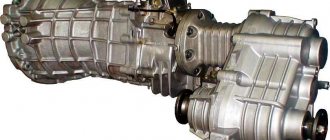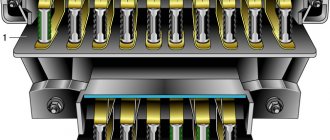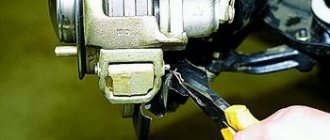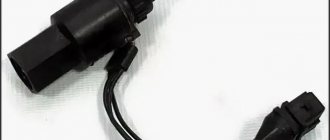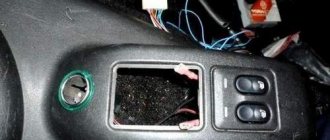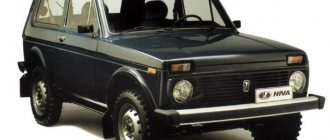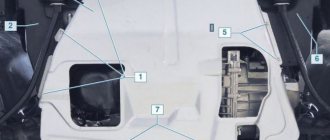In 2002, GM-AvtoVAZ began serial production of the Chevrolet Niva. This model has retained all the advantages of the old Niva - the presence of permanent all-wheel drive, a locked center differential, as well as a two-speed manual gearbox.
Chevrolet Niva has 6 trim levels, namely: L, LC, LE, GL, GLC and LE+. The last of them was presented in 2015. It differs from the rest in the presence of air conditioning, a full safety package, Continental Cross Contact tires, K&K “Camelot” wheels, special rear bumper protection, a towbar, as well as unpainted moldings.
To make driving easier, the manufacturer equipped the car with hydraulic power steering (power steering).
Let's look at what fluids are used in power steering Niva Chevrolet, how to check the oil level and replace it yourself.
Types of power steering fluids for Chevrolet Niva
The original working fluid for power steering Niva Chevrolet is Pentosin CHF 11S.
Among its analogues we can note PSF, which has almost the same characteristics, but at a more reasonable price. Pentosin is green, PSF is red or yellow.
In addition to the mentioned oils, it is worth highlighting Mannol Dexron III. This fluid is multi-purpose - it can be used not only in power steering, but also in automatic transmissions, clutches, and other similar mechanisms. Dextron has good low-temperature and antioxidant properties and an increased service life.
Reservoir for windshield and brake fluid.
Page 62
Another filling capacity of the Chevrolet Niva is two glass washer reservoirs, the capacity of which is five and two liters.
And also interesting: 245 golden Niva Lada, Automotive enamel Mobilehel metallic, pack. 1 l
This model has two independent braking systems. The working one has a hydraulic drive, the parking one has a mechanical drive. The contours are separated from each other.
The hydraulic drive includes a special tank made for brake fluid.
- DOT-4 brake fluid is suitable for half-liter hydraulic brakes. The product has improved characteristics and has a boiling point of over 235 degrees. Well suited for regions with low ambient temperatures.
- SAEJ1703, FMSS116 are used for the entire hydraulic system and clutch release (0.15 l). The synthetic product provides good lubrication and reduces oxidation at high temperatures.
- The tank lid hatch hinges, door and hood locks require VTV-1 and FIOL-1 greases. Hinges of steering rods and cardan shafts - ShRB-4, Litin 2, Esma.
- The air conditioner also has two tanks. One of them is for oil (0.22 l), the other is for refrigerant (0.650 kg).
Chevrolet Niva reservoirs for refilling liquids and lubricants are quite reliable and convenient when you need to make a replacement.
Various tags and sensors make it possible to carry out control almost immediately, which allows you to avoid an emergency situation.
Frequency of power steering fluid replacement
It is believed that the oil that was filled into the power steering of a Chevrolet Niva does not require replacement throughout the entire life of the vehicle. However, if there is damage to the steering rack, various contaminants may enter the system.
Over time, the fluid forms sediment, which affects its quality; the temperature difference between winter and summer also negatively affects the condition of the oil in the power steering. This is why it needs to be replaced approximately every six years, regardless of condition.
Signs of trapezoidal problems
Even with careful driving, the trapezoid has its resource, although Chevrolet Niva owners note that it reaches 100,000 km. In fact, the information is not entirely accurate. Every 25 - 30 thousand km, it may be necessary to replace the steering tips, and they are an integral part of the trapezoid.
The first sign of a joint failure is increased play in the steering wheel. The hinge pins wear out and need to be replaced. Recently, drivers prefer to purchase rods or ends assembled with a hinge. Lack of lubrication will accelerate wear of the moving joint. Although the manufacturer adds the required amount of lubricant to the joint, compliance with this obligation should be checked.
Three factors have been identified that lead to trapezoidal faults.
- Poor quality of road surface.
- Driving style.
- Manufacturing defects.
In any case, it is necessary to carry out repair work as quickly as possible. The condition of the steering system determines the safe operation of the vehicle. It should be noted that prolonged absence of repair will lead to complete destruction of the hinge. On the highway, the car will become uncontrollable, which can lead to an accident.
Read news about the new Niva
- Steering tips Niva Chevrolet
- What tire size is available for installation on Niva, available versions and recommendations
- Mud tires for Niva 4x4: radius 15 and 16 - which one is better to install "
- All about the Valet button and how to disable it yourself on alarm systems of different brands
- Niva Lynx buy in Samara - prices for the new Lada “Bronto” (Niva Pickup) | cost and equipment
- Air conditioning Niva Chevrolet - design and repair "
- Niva Chevrolet installation of air conditioning - Auto magazine MyDucato
- Instrument panel Niva Chevrolet designations. Improving the Chevrolet Niva dashboard
Checking the fluid level
The power steering reservoir in the Niva Chevrolet is installed on the left side of the engine compartment. It is connected to the pump and steering mechanism by flexible hoses.
To check the fluid level in the reservoir, unscrew the cap.
The oil should reach the middle of the segment between the marks on the dipstick.
changing the oil in a gur sheviniva - logbook of the 2009 Chevrolet Niva L on DRIVE2
I forgot to take a camera and take a picture of how it was and what happened. And it’s -15 outside. So I didn’t like the condition of the thick hose, all cracked, and I decided to replace it. At the same time, I need to change the oil because Neither I nor the old owner know what kind of oil was poured in there (apparently it hasn’t been changed from the factory), but the color is green. After reading the forums, I decided to take the red SHELL DONAX. I drained the old one, changed the reservoir for a new one (since there is a filter there, I decided to be on the safe side and replace it), filled in new oil, pumped it out. The old one looks darkish but without impurities. One minus is that you need to bleed the air, but I don’t know where this valve is. I’ll look for it. I bleed the air through the open tank cap. I hope nothing breaks))) ah Yes, for some reason the book says that the oil volume in the power steering is 1.7, but I got 1.3 and the old one came out of the system. The level in the tank is still there. The steering wheel is turned in all directions, everything works fine. There is no more hissing when the steering wheel is all the way to the side (but this may be due to the tank cap) I’ll keep an eye on what might change. Oil-480 for 1l hose 16-1m 140r tank-350r
and here is the link www.autoprospect.ru/chevr…rulevogo-upravleniya.html
Mileage: 33346 km
Do-it-yourself power steering fluid replacement
To change the fluid in the power steering, unscrew the clamp bolt of the bracket, loosen the clamp of a suitable hose and remove the reservoir to remove the old oil into a previously prepared container.
Start the engine and turn the steering wheel 3-4 times in different directions until it stops. As the liquid drains, add fresh liquid.
Repeat the operation until new oil begins to come out of the outlet hose.
Reinstall the reservoir and check the fluid level - it should be at the top mark of the dipstick.
What tools for preparation
Special tools do not require changing the oil in the power amplifier. One key number 10. Fixed screwdriver. And a container for liquid that will drain. Due to the tightness of the engine compartment, it is best to take a cut plastic bottle. Well, the process itself First, release the clamping cup clamp from the key. Wipe it gently with a cloth. It is necessary that dirt accidentally gets into the tank. Only then carefully unscrew the tank cap using the level indicator. Carefully pour the liquid into the bowl. Using a screwdriver, loosen the hose clamp from the power steering to the tank. This is a drain hose. Hole in tank, connection to remote hose, plug. The hose itself is directed into a container to drain the liquid.
Bleeding the system
To bleed the power steering system on a Chevrolet Niva, place the steering wheel in the middle position and start the engine for a few seconds. Do not turn the steering wheel. After this, turn off the car and turn the steering wheel all the way in any direction.
Remove the protective cap from the special valve using a wrench to bleed any remaining air from the system.
Then turn the steering wheel in the other direction, leaving the air bleed valve open. After the air lock and some liquid come out, close the valve. If necessary, add power steering fluid to the maximum mark. Start the engine and turn the steering wheel in different directions until it stops. Do this until air bubbles stop escaping into the tank.
Bleeding the hydraulic clutch of Niva Chevrolet
If, when the pedal is pressed all the way, the clutch does not disengage completely (“drives”), which is accompanied by a characteristic grinding of gears when engaging reverse gear, there may be air in the clutch hydraulic drive. Remove it by bleeding the drive. In addition, pumping is performed when the hydraulic drive is filled with fluid after its replacement or after repair of system components associated with its depressurization.
You will need: an “8” wrench, a bleeder hose, a container for brake fluid, brake fluid.
Carry out the work with an assistant in the inspection ditch.
1. Pour (or add) liquid into the tank to the bottom edge of the filler neck.
2. Place a bleeder hose onto the slave cylinder valve. Place the other end of the hose in a container with a small amount of brake fluid so that it is submerged in the fluid.
The design of the Niva Chevrolet steering linkage and its features
The Chevy Niva steering linkage is a movable structure of interconnected elements. The main components are:
- Bipod;
- Pendulum arm (steering pendulum);
- Medium thrust;
- Lateral thrust (right and left);
- Steering knuckles.
A bipod is nothing more than an all-metal lever that is mounted on the steering shaft. The left tie rod is pivotally attached to the end of the lever. The middle link serves to transfer force to the right wheel.
For it, the second support point is the steering pendulum, movably mounted in a special bracket. This pendulum plays the role of a second lever, transmitting force to the right steering rod. Steering knuckles do not belong to the trapezoid, but are often considered as part of the steering system and allow a more detailed description of the process of driving a car.
On Shevik, the side rods consist of two parts. They are connected to each other by a split coupling, which has internal left and right threads on different sides. When the clutch rotates, both parts of the side rod converge or diverge, changing the distance from the bipod or pendulum to the steering knuckle. Thus, it is possible to set a certain wheel toe angle. Typically, the part of the side rod that faces the wheel is called the tie rod end.
Absolutely all Niva Chevrolet trapezoid rods have hinges at the ends. The hinge pins are designed for a conical fit and are tightened with nuts when connected. Hinges allow the trapezoid parts to remain movable relative to each other and relative to the car body. Some car enthusiasts are inclined to believe that the elements of the Shevik steering linkage are suitable for the classic Niva and vice versa.
To describe the operation of the entire vehicle control system, it is enough to indicate the main directions of force transmission from the steering wheel. By means of a worm gear, the rotation of the shaft with a gain in force is converted into rotation of the steering bipod. It is simultaneously connected to the left and middle rods. An analogue of a bipod is a pendulum that can rotate freely in the bracket.
When a car turns, the wheels describe a circle of different radii. Provided that the angular velocity on the axle is the same, one wheel will certainly slip. This leads to increased tire wear and poor handling. The solution to the problem comes down to the fact that during a maneuver the steering knuckles must turn at different angles relative to the straight line of motion of the car.
This ratio can be ensured by correct selection of the inclination of the levers, as well as their length. If it is not possible to completely eliminate slipping, then it is necessary to reduce it to a minimum. The wheel alignment angle must be adjusted after any repair work on the trapezoid. It is especially often necessary to change the steering tip, and it is recommended to replace it on both sides at once.
And also interesting: Do-it-yourself modifications to the Niva 2121 “
Features of operating a Chevrolet Niva car affect the condition of the trapezium elements, so it is important to periodically carry out diagnostics. In order not to lead to the failure of the linkage joints, it is necessary to check the integrity of the protective covers. During the inspection, attention is paid to the presence of cotter pins on the hinge pins, and the absence of deformation or damage to the rods is also checked.
